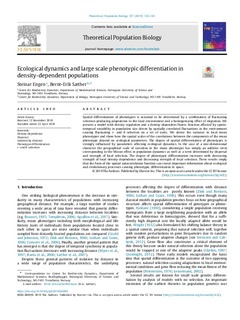| dc.contributor.author | Engen, Steinar | |
| dc.contributor.author | Sæther, Bernt-Erik | |
| dc.date.accessioned | 2020-02-10T15:20:32Z | |
| dc.date.available | 2020-02-10T15:20:32Z | |
| dc.date.created | 2019-07-02T20:01:32Z | |
| dc.date.issued | 2019 | |
| dc.identifier.citation | Theoretical Population Biology. 2019, 127 133-143. | nb_NO |
| dc.identifier.issn | 0040-5809 | |
| dc.identifier.uri | http://hdl.handle.net/11250/2640865 | |
| dc.description.abstract | Spatial differentiation of phenotypes is assumed to be determined by a combination of fluctuating selection producing adaptations to the local environment and a homogenizing effect of migration. We present a model with density regulation and a density-dependent fitness function affected by spatio-temporal variability in population size driven by spatially correlated fluctuations in the environment causing fluctuating - and -selection on a set of traits. We derive the variance in local mean phenotypes and show how the spatial scales of the correlations between the components of the mean phenotype depend on ecological parameters. The degree of spatial differentiation of phenotypes is strongly influenced by parameters affecting ecological dynamics. In the case of a one-dimensional character the geographical scale of variation in the mean phenotype has simply an additive term corresponding to the Moran effect in population dynamics as well as a term determined by dispersal and strength of local selection. The degree of phenotypic differentiation increases with decreasing strength of local density dependence and decreasing strength of local selection. These results imply that the form of the spatial autocorrelation function can reveal important information about ecological and evolutionary processes causing phenotypic differentiation in space. | nb_NO |
| dc.language.iso | eng | nb_NO |
| dc.publisher | Elsevier | nb_NO |
| dc.rights | Navngivelse 4.0 Internasjonal | * |
| dc.rights.uri | http://creativecommons.org/licenses/by/4.0/deed.no | * |
| dc.title | Ecological dynamics and large scale phenotypic differentiation in density-dependent populations | nb_NO |
| dc.type | Journal article | nb_NO |
| dc.type | Peer reviewed | nb_NO |
| dc.description.version | publishedVersion | nb_NO |
| dc.source.pagenumber | 133-143 | nb_NO |
| dc.source.volume | 127 | nb_NO |
| dc.source.journal | Theoretical Population Biology | nb_NO |
| dc.identifier.doi | 10.1016/j.tpb.2019.04.005 | |
| dc.identifier.cristin | 1709597 | |
| dc.relation.project | Norges forskningsråd: 267511 | nb_NO |
| dc.relation.project | Norges forskningsråd: 274930 | nb_NO |
| dc.relation.project | Norges forskningsråd: 23257 | nb_NO |
| dc.description.localcode | © 2019 The Authors. Published by Elsevier Inc. This is an open access article under the CC BY license (http://creativecommons.org/licenses/by/4.0/) | nb_NO |
| cristin.unitcode | 194,63,15,0 | |
| cristin.unitcode | 194,66,10,0 | |
| cristin.unitname | Institutt for matematiske fag | |
| cristin.unitname | Institutt for biologi | |
| cristin.ispublished | true | |
| cristin.fulltext | original | |
| cristin.qualitycode | 1 | |

